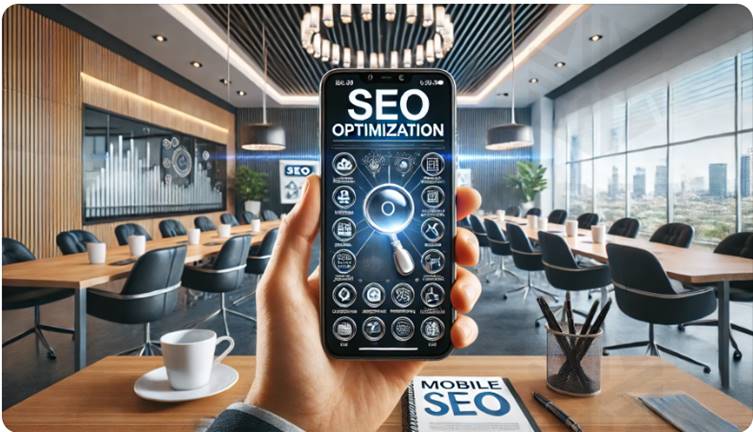As mobile devices become the primary means of accessing the internet, mobile SEO training is crucial for any digital strategy. Mobile optimization ensures that websites are not only accessible but also provide a seamless user experience, which is a critical factor for search engine rankings. This article explores the importance of mobile optimization, understanding mobile user behavior, best practices for mobile-friendly design, local SEO strategies, and optimizing for mobile-specific search features.
The Importance of Mobile Optimization for SEO
Mobile optimization is no longer optional; it’s essential. With mobile-first indexing, Google primarily uses the mobile version of a site for indexing and ranking. This shift underscores the importance of ensuring that your site is mobile-friendly.
Mobile Usage Statistics:
- Over 50% of global web traffic comes from mobile devices .
- Google reports that 61% of users are unlikely to return to a mobile site they had trouble accessing, and 40% visit a competitor’s site instead .
Benefits of Mobile Optimization:
- Improved User Experience: A mobile-optimized site provides a better user experience, which can reduce bounce rates and increase engagement.
- Higher Rankings: Google’s mobile-first indexing means that mobile-friendly sites are more likely to rank higher in search results.
- Increased Conversions: Mobile users are often looking for quick solutions, making a seamless mobile experience crucial for conversions.
Understanding Mobile User Behavior and Intent
Understanding how mobile users interact with websites and their intent is key to effective mobile SEO.
User Behavior:
- On-the-Go Searches: Mobile users often search while on the go, looking for quick answers and immediate solutions.
- Local Searches: Many mobile searches have local intent, such as finding nearby businesses or services.
- Voice Search: Increasingly, users are relying on voice search for convenience, which affects how content should be optimized.
User Intent:
- Informational Intent: Users looking for specific information or answers to questions.
- Navigational Intent: Users seeking a particular website or app.
- Transactional Intent: Users ready to make a purchase or complete an action.
Key Takeaways:
- Tailor content to be concise and easily digestible on mobile devices.
- Focus on local SEO to capture users searching for nearby solutions.
- Optimize for voice search by using natural language and question-based keywords.
Best Practices for Mobile-Friendly Design and Content
Implementing best practices for mobile-friendly design and content ensures a seamless experience for users.
Responsive Design:
- Fluid Grids: Use fluid grids that automatically adjust to different screen sizes.
- Flexible Images: Ensure images scale appropriately on various devices.
- Media Queries: Implement media queries to apply different styles for different devices.
Mobile-Friendly Content:
- Concise Text: Write concise and clear content that is easy to read on small screens.
- Readable Fonts: Use legible fonts and appropriate font sizes to enhance readability.
- Touch-Friendly Elements: Ensure buttons and links are large enough to be easily tapped.
Page Speed Optimization:
- Minimize HTTP Requests: Reduce the number of elements on your page to decrease load times.
- Enable Compression: Use Gzip to compress files and speed up loading.
- Optimize Images: Compress and resize images to reduce load times.
User Experience (UX) Considerations:
- Simplify Navigation: Use a simple and intuitive navigation structure.
- Avoid Pop-Ups: Avoid intrusive pop-ups that can frustrate mobile users.
- Utilize White Space: Use white space effectively to avoid clutter and improve readability.
Local SEO Strategies for Mobile Devices
Local SEO is critical for capturing mobile users with local intent.
Google My Business (GMB):
- Complete Profile: Ensure your GMB profile is complete and accurate with business hours, contact information, and photos.
- Encourage Reviews: Encourage satisfied customers to leave positive reviews, which can enhance your local search rankings.
Local Keywords:
- Geo-Targeted Keywords: Use keywords that include local terms such as city names, neighbourhoods, or landmarks.
- NAP Consistency: Ensure that your Name, Address, and Phone number (NAP) are consistent across all online directories and your website.
Local Content:
- Create Local Content: Develop content that is relevant to your local audience, such as local news, events, and guides.
- Local Backlinks: Acquire backlinks from local websites, blogs, and business directories.
Mobile-Friendly Local Pages:
- Location Pages: Create dedicated location pages for each of your business locations with local keywords and relevant information.
- Mobile Maps: Ensure your location pages integrate with mobile maps and provide clear directions.
Optimising for Mobile-Specific Search Features Such as App Indexing and Searches Within Apps
Mobile-specific search features, including app indexing and in-app search, are essential for mobile SEO.
App Indexing:
- Deep Linking: Implement deep linking to allow Google to index content within your app, making it searchable.
- App Content Optimization: Optimize the content within your app just like web content, using relevant keywords and clear descriptions.
In-App Search:
- Search Features: Implement search features within your app to enhance user experience and make it easier for users to find what they need.
- Optimized Metadata: Ensure your app’s metadata is optimized for search engines, including the app title, description, and screenshots.
Progressive Web Apps (PWAs):
- Hybrid Approach: PWAs combine the best of web and mobile apps, offering a fast, reliable, and engaging user experience.
- SEO-Friendly: PWAs are indexable by search engines, providing an SEO advantage over traditional mobile apps.
Voice Search Optimization:
- Natural Language: Optimize content for natural language queries commonly used in voice search.
- Featured Snippets: Aim for featured snippets by providing concise and clear answers to common questions.
Conclusion
SEO for mobile devices is an essential aspect of any comprehensive SEO strategy. By understanding the importance of mobile optimization, analyzing mobile user behavior, implementing best practices for mobile-friendly design, focusing on local SEO, and optimizing for mobile-specific search features, businesses can significantly enhance their mobile presence and drive more traffic. Continuous learning and adaptation are key to staying ahead in the rapidly evolving world of mobile SEO.
FAQs
What is mobile-first indexing, and why is it important? Mobile-first indexing means that Google primarily uses the mobile version of a site for indexing and ranking. It’s important because it reflects the shift towards mobile usage, ensuring that mobile-friendly sites are prioritized in search results.
How can I improve my website’s load time on mobile devices? To improve load time, minimize HTTP requests, enable compression, optimize images, leverage browser caching, and reduce server response time. Tools like Google PageSpeed Insights can provide specific recommendations.
What is the role of AMP in mobile SEO? Accelerated Mobile Pages (AMP) is a framework for creating fast-loading mobile web pages. AMP improves user experience by reducing load times, which can positively impact SEO rankings.
Why is local SEO particularly important for mobile users? Local SEO is crucial for mobile users because they often search for nearby services and businesses. Optimizing for local search helps capture this intent and drive local traffic to your business.
How does voice search affect mobile SEO strategies? Voice search affects mobile SEO strategies by requiring optimization for natural language queries and question-based keywords. As voice search usage grows, focusing on long-tail keywords and providing clear answers becomes increasingly important.



